Updated: March 25, 2019
When it comes to the top of the robot vacuum food chain, the Roomba 980 debuted in the top spot and remained there virtually unchallenged. Now, the Roomba i7 Plus (i7+) is trying to claim that position. Does it?
The i7+ is the culmination of years of technology and advancement in robotics. According to the iRobot CEO Colin Angle, the i7+ “represents the most advanced robotic vacuum ever built.”
Prior to the i7 and i7+ release, the Roomba 980 was arguably the best robot vacuum on the market. So what happens when we compare these robots against each other? That is precisely what I will uncover in this article.
Read the full report below to find out everything you wanted to know about i7+ and see how it compares against the highly reputable 980.
Here is the bottom line:
We recommend the Roomba i7+ for most people.
⭐ The Roomba 980 had been the best robot vacuum for a very long time. It has strong suction, navigates multiple rooms with ease, and is able to resume vacuuming where it left off.
⭐ The Roomba i7+ has the benefits of the 980 plus the ability to empty itself and clean only the specified rooms. The only downside to this vacuum is the price.
If you want the best robot vacuum on the market, the clear winner is the Roomba i7+.
Contents
- 1 Money Saving Tip
- 2 The Differences
- 3 The Similarities
- 4 What about the i7 (without the plus)?
- 5 Specifications Chart
- 6 Dimensions, Features and Options
- 7 Frequently Asked Questions
- 7.1 Q. What Happens when these robots run over a cord or something they shouldn’t pick up?
- 7.2 Q. When is the robot going to be available for purchase?
- 7.3 Q. With the brushless extractors, what happens if the robot runs over power cords or throw rugs?
- 7.4 Q. What kind of containment can be used with the robots?
- 7.5 Q. What happens when parts wear out?
- 8 What I Like About the Roomba 980
- 9 What I Like About the Roomba i7+
- 10 What I Really Like About the Roomba i7
- 11 In Conclusion
Money Saving Tip
Skip the “plus” and get the Roomba i7 instead. It’s a better vacuum than the already excellent, top of the line Roomba 980.
You can always upgrade to the i7+ from the i7 later by purchasing the self-emptying dock (which is quite noisy and expensive to buy bags for anyway).
Continue reading for the full breakdown.
The Differences
The two models are a lot alike, and when you see them in action, you will know what the i7+ kept from the 900 series. There are differences though, which include the following:
- The Roomba 980 uses iAdapt 2.0 navigation technology while the i7+ uses the newer iAdapt 3.0.
- The i7+ remembers the layout of your house and uses Imprint Smart Mapping, which allows you to select specific rooms for cleaning. This is not available on the 980.
- You don’t have to manually empty the collection bin on the i7+ like you will with the 980.
- The Roomba 980 has a collection bin that needs to be wiped out; the Roomba i7+’s collection bin is washable.
The Similarities
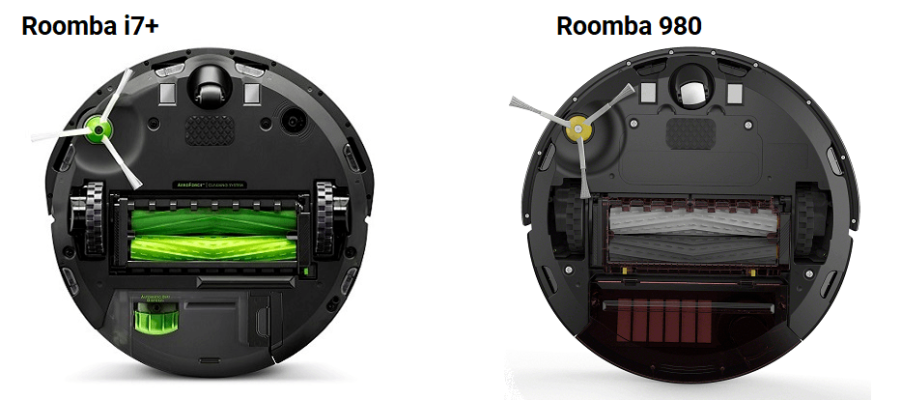
The two models aren’t without their similarities. While I won’t give you an exhaustive list, (we don’t have that kind of time). However, the most important facets are:
- Both units automatically recharge their batteries and resume cleaning when fully charged.
- Each will map your home and allow you to see cleaning reports through the mobile app.
- The 980 and the i7+ make use of wireless technology for mobile apps and voice commands.
- Both units have 10x the air power of Roomba 600 series.
- Each robot has dirt detection sensors to highlight and deep clean especially dirty areas of the home.
- The i7+ and 980 both have HEPA quality filters for allergen reduction.
- You will find brushless rollers on both models.
- The batteries are the same in both the Roomba 980 and the i7+.
- Both use virtual wall barrier beacons to for containment.
- Third party integration with Amazon, Google, Wink, SmartThings and IFTTT are possible through both models.
What about the i7 (without the plus)?
In other words, what’s the difference between Roomba i7 and Roomba i7+?
The i7+ comes packaged with the Clean Base, the i7 does not. The vacuum units themselves are exactly the same, except the i7+’s dust bin is compatible with the Clean Base. For more details, see our full article on the i7 and i7+.
If you don’t have time to read the whole article, here’s the bottom line: pick up the Roomba i7 over the i7+. You can always upgrade to the i7+ by purchasing the Clean Base later.
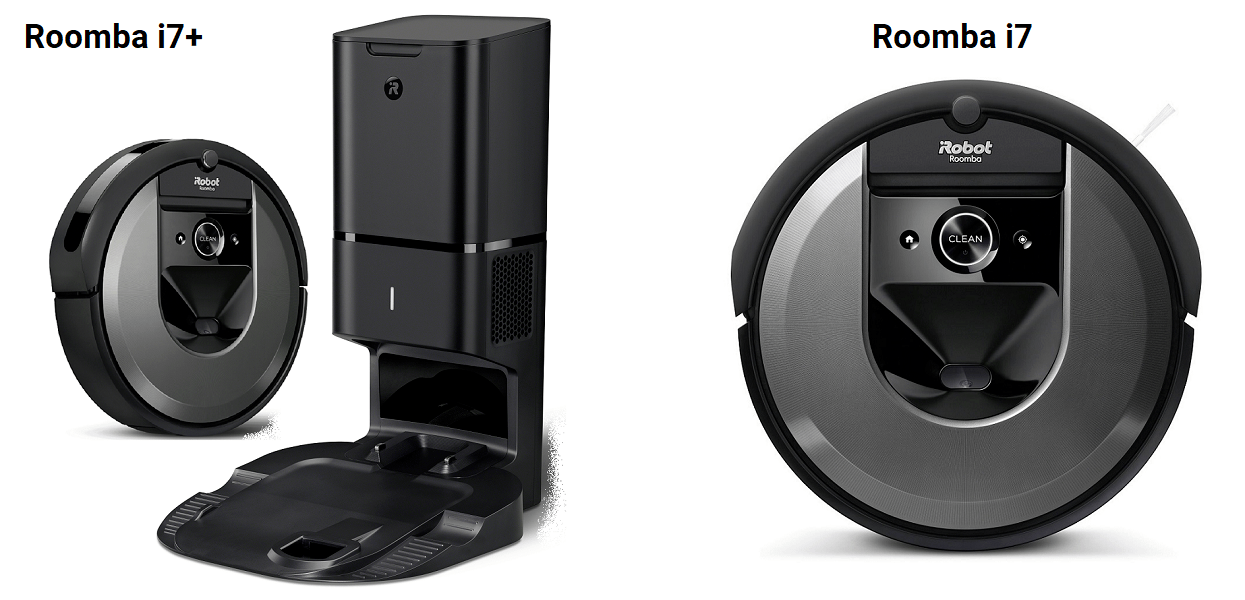
Now back to the comparison betwen i7+ and 980.
Specifications Chart
Let’s take a look at the two Roomba models side by side. You will be able to see what each robot does and doesn’t offer.
| Roomba 980 | Roomba i7+ | |
| Size | 13.8 x 13.8 x 3.6 inches | 13.34 x 13.34 x 3.63 inches |
| Weight | 8.7 pounds | 7.44 pounds |
| Navigation | iAdapt 2.0 | IAdapt 3.0 |
| Battery | 3300mAh lithium-ion | 1800mAh lithium-ion |
| Runtime | Up to 120 minutes | Up to 120 minutes |
| Charge Time | 3 hours | 3 hours |
| Automatic Recharge | Yes | Yes |
| Entire Level Clean | Yes | Yes |
| Carpet Boost | Yes | Yes |
| Drop Sensors | Yes | Yes |
| Bump Sensors | Yes | Yes |
| Dirt Detection Sensors | Yes | Yes |
| Camera Navigation | Yes | Yes |
| Wireless Communications | Yes | Yes |
| Mobile App | Yes | Yes |
| Voice Controls | Yes | Yes |
| Floor Types | All | All |
| Imprint Smart Mapping | No | Yes |
| Collection Bin Capacity | 0.5L | 0.7L |
| Collection Bin Washable | No | Yes |
| Automatic Collection Bin Emptying | No | Yes |
| Side Brushes | 1 Side Brush | 1 Side Brush |
| Containment | Dual Mode Virtual Wall Barrier | Dual Mode Virtual Wall Barrier |
| Warranty | 1 year | 1 year |
| Price | Check on Amazon | Check on Amazon |
Dimensions, Features and Options
Let’s take a look at the features of the two models with some scrutiny. We need to find out if the claims hold up.
The Roomba 980’s navigation makes it vacuum in straight lines
The navigation and mapping technology, which iRobot calls iAdapt, has gone through a few upgrades over the last few years. The camera-based navigation and mapping (iAdapt 2.0) propelled the 900 series to the top of the industry.
For the first time, the robots could see the home, create a visual map of the floor plan and surroundings. It also allowed the robots to clean in a human-like manner using parallel lines.
The mapping is also represented on the mobile app allowing you to see where the robot has been and what areas are left to be cleaned. The other sensors are also integrated into the iAdapt technology.
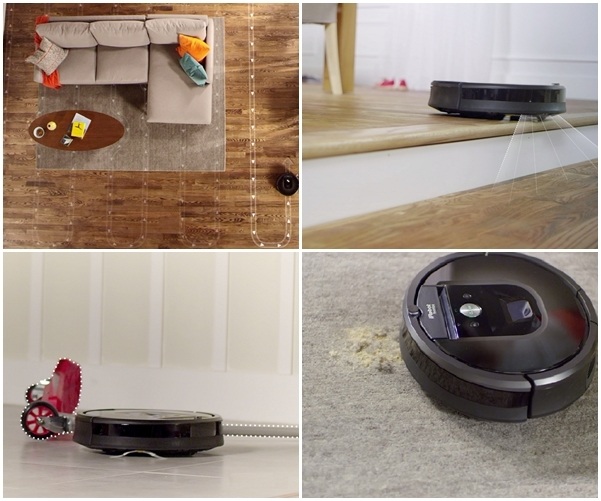
The drop sensors keep the robots on the ground. They use infrared technology to detect large drops such as stairs or ledges. When these are detected, the robot will stop and change direction.
The drop sensors also prevent the robots from getting high-centered by not allowing the machines to go over a height variance of an inch and a half. The brush rolls also self-adjust based on the type and height of the floor the robot is on, the drop sensors relay floor height information to the self-adjusting motors.
The bump sensors keep the robots from running full force into walls and furniture. These use a combination of infrared and acoustic sensors. The acoustic sensors send out a signal trying to detect large objects like walls.
When they are detected, the robot will slow down until it eventually hits the obstacle. If the robot has already detected the obstacle in previous passes, the mapping will alert the robot if it is passable or not.
Passable objects such as curtains and bed skirts will be pushed through by the robots where non-passable objects will cause the robot to get as close as possible without causing damage.
The main navigation and mapping, of course, comes from the camera mounted on the robot’s frame. The camera takes photos as the robot moves around, creating a make-shift video that is stored in the memory of the robot.
These constantly updated photos allow the robots to know where they are in the home, what they have already cleaned and what areas are yet to be covered.
The i7 and i7+’s navigation software remembers your floor plan
With 3.0, the i7+ takes the sensors up a notch. The iAdapt 3.0 model adds a little bit more to the system.
The first thing you will notice is the dirt detection system has been upgraded. In addition to detecting heavily soiled areas, it will also make a note of these areas and begin to map and remember them.
As the i7+ runs a cleaning cycle, it will perform a more thorough clean in these remembered areas each time.
Secondly, the upgrades to the system allow the robot to map multiple floor plans. That’s right, plural. The i7+ can map and remember up to 10 different floor plans.
Not only will it map your entire home, all of your floors, it will also remember your neighbor’s house, your mother’s home and anywhere else you decide to take it.
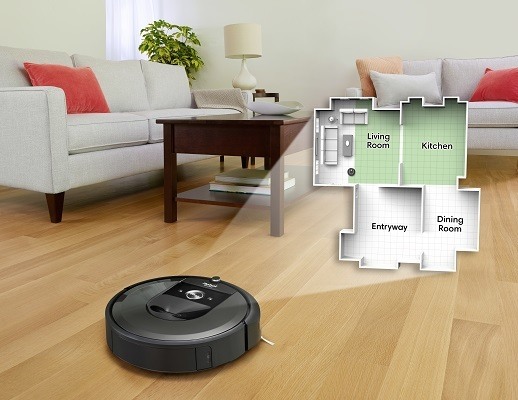
For each floor it has mapped, it creates landmarks for each plan so it can quickly figure out which floor plan to use. These landmarks can be such things as pieces of furniture, end tables, bookshelves, etc.
The technology also allows you to move furniture around, or rearrange a room. The Roomba i7+ will not only recognize the changes but update the map it has in memory and know what map to update properly.
I will cover another major feature later when I talk about the mobile app controls. While it is technically an upgrade for the iAdapt 3.0 technology, it is part of the mobile app in actual use.
Bottom Line: The i7+ wins with its improved navigation and ability to store maps.
Collection Bins and Maintenance
The collection bins are one of the most important, yet overlooked aspects of a robotic vacuum. Smaller bins need to be emptied more often, and when they get full, the robots will stop running until you clean them.
Roomba 980 has a pretty large collection bin already, and you don’t have to pay for replacement bags
The Roomba 980 has a large 0.5L collection bin that can last a couple of cleaning cycles before needing to be emptied. Of course, this will depend on how large your floor plan is and how dirty the floors are.
When the collection bin gets full, you remove it and empty it into the trash. You should also take this time to perform the general maintenance. Check the filter to see if it needs to be cleaned off or knocked out. Every four to six months the filter will need to be replaced.
Before you replace the collection bin you should wipe it out with a dry cloth to keep the sensors clean and the collection bin completely empty.
The other steps are pretty routine. Check the air passage and brushless extractors for tangles and debris. Finally, wipe off the external sensors to keep the infrared sensors free of dust and debris.
The i7+ empties its own dust bin, but replacement bags cost money
The i7+ will follow the same maintenance schedule as the 980 with one large, notable exception: you don’t need to empty the collection bin.
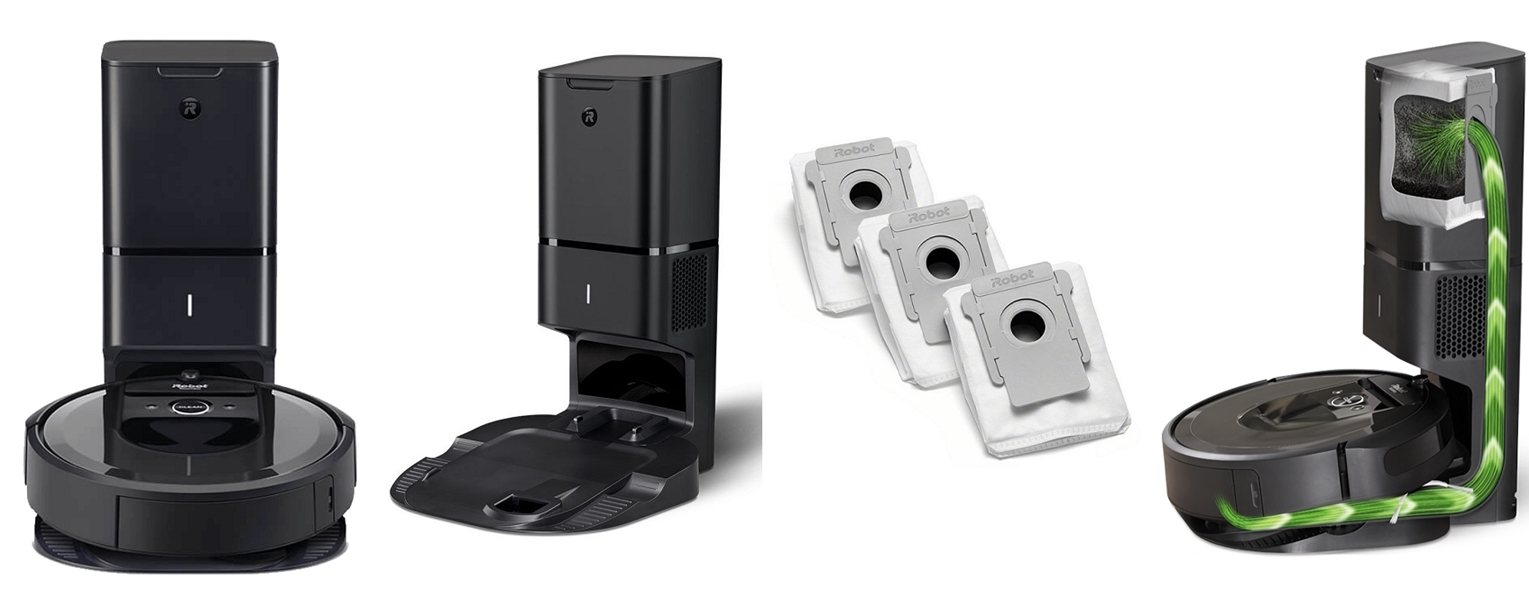
The Roomba i7+ charging dock is a lot different than previous versions. The dock will still hold the robot and recharge the batteries. However, it also has a 12-inch tall tower. This tower (that iRobot calls the Clean Base Automatic Dirt Disposal.) has a lid on the top and when you open it, there is a bag inside.
This bag holds the contents of the collection bin. In fact, the bag will hold the contents of 30 i7+ collection bins. When the robot returns to the charging dock the contents of the collection bin are suctioned out from the bottom of the bin and transported to the bag waiting in the tower.
When the tower is full, after about 30 fills, you will get notified through the mobile app. When you receive the notification, you will pull out the bag (it automatically seals shut) and toss it in the trash.
When you do your routine maintenance on the i7+, you need to clean out the collection bin. The collection bin of the new model is washable. While you cannot toss it in the dishwasher, you can put it under the tap and rinse it out.
The entire process means you never have to empty a collection bin again. It also means that you have to periodically buy replacement vacuum bags, adding to the overall cost of the vacuum.
The best way to get around this is to get the significantly cheaper i7 and empty the vacuum yourself. The i7 has all the pros of the i7+ except for the ability to self-empty, but without the hefty price tag of the i7+.
Bottom Line: The Roomba i7 is the way to go. While never having to empty the dust bin on the i7+ is awesome, the added cost is only worth it for specific cases. (e.g. severe allergies).
The Batteries are Large and Provide Adequate Power for the Units
One important factor for all robotic cleaners is the battery size and capabilities.
Both the 980 and the i7+ use a large-celled 3300mAh lithium-ion battery pack that will run for up to two full hours. This is plenty of time to clean most average to large sized homes and even with a mixture of carpet and hard flooring the robots can cover up to 1800 square feet or more on a single charge.
However, this also depends on how many obstacles are in the cleaning path and how dirty the floors are. Heavily soiled areas will engage the deep cleaning modes and potentially the carpet boost feature that increases speed and suction on the carpet.
There is nothing to worry about, though, once the robots have begun a cleaning cycle, they will be completed. If the batteries get too low the memory of the robot will mark its location on its internal map and return to the charging station.
Once the batteries are fully charged (about 3 to 4 hours on average), the robots will return to the area marked on the map and continue cleaning where they left off. You can, of course, cancel the cleaning cycle if you wish, through the mobile app or voice commands, but there isn’t a need unless you just don’t want the robot to finish.
Bottom Line: This round is a tie. Both robots use the same battery and have the same expected runtime and recharge times.
Use Voice, Touch or Press to Control Your Robot
The Roomba 980 can be controlled remotely via the app or voice
Control of the robot hasn’t changed very much. You still have limited local controls, the use of voice commands and the industry-leading mobile app.
The local controls are the same for both models. You can perform a spot clean, return the robot to the charging dock or press the large “clean” button.
Voice commands also stay the same between the models. Using an Amazon Alexa or Google Home enabled device you can use various voice commands to control the robot.
But let’s get to the good part. The mobile app is one of the better robotic mobile apps on the market. It is a free download from the respective Google or Apple iOS stores and it will be the basis for all of your control options.
Through the app, you are able to do things like:
- name your robot (useful for voice commands),
- set various cleaning preferences
- start, stop, pause or resume a cleaning cycle.
- select the cleaning mode
- return the Roomba to the charging dock.
You have the automatic mode, which is the standard “go clean my floors the best way you know how” method. You have spot clean for a particular quick mess that needs to be cleaned, and edge cleaning mode.
Edge cleaning mode is just what it sounds like. The robot will scurry along the edges of the house cleaning baseboards and corners only.
Imprint mapping lets you request the i7 or i7+ to clean a specific room. Click here for iRobot’s PDF fact sheet showing the i7+’s capabilities.
The i7+ (and i7) is different though. There is another feature that the Roomba 980 doesn’t have.
iRobot has dubbed this feature “Imprint Smart Mapping.” This is quite an advance in the mapping feature and you can take advantage of it through the mobile app or even your voice.
The robot will need a few runs through your home before this mapping is complete. Here is how it works:
- After two to four cleaning and mapping runs through your home, the i7+ will have a detailed map of your home. This map will include individual rooms, including doorways, walls and larger furniture.
- Once the mapping is done, you can use the app to label the rooms of your home (i.e., kitchen, living room, master bedroom, etc.).
- From then on, you can use the app to tell the Roomba i7+ to clean only specific rooms.900 series to the top of the industr
When you create a schedule or send the robot out to do a cleaning cycle, you can select specific rooms from the map on the mobile app screen and the robot will only clean those rooms.
Remember, with iAdapt 3.0, you can store up to 10 maps, meaning you can select specific rooms on different maps for cleaning only. You will need to transport the robot to the new floor first, of course.
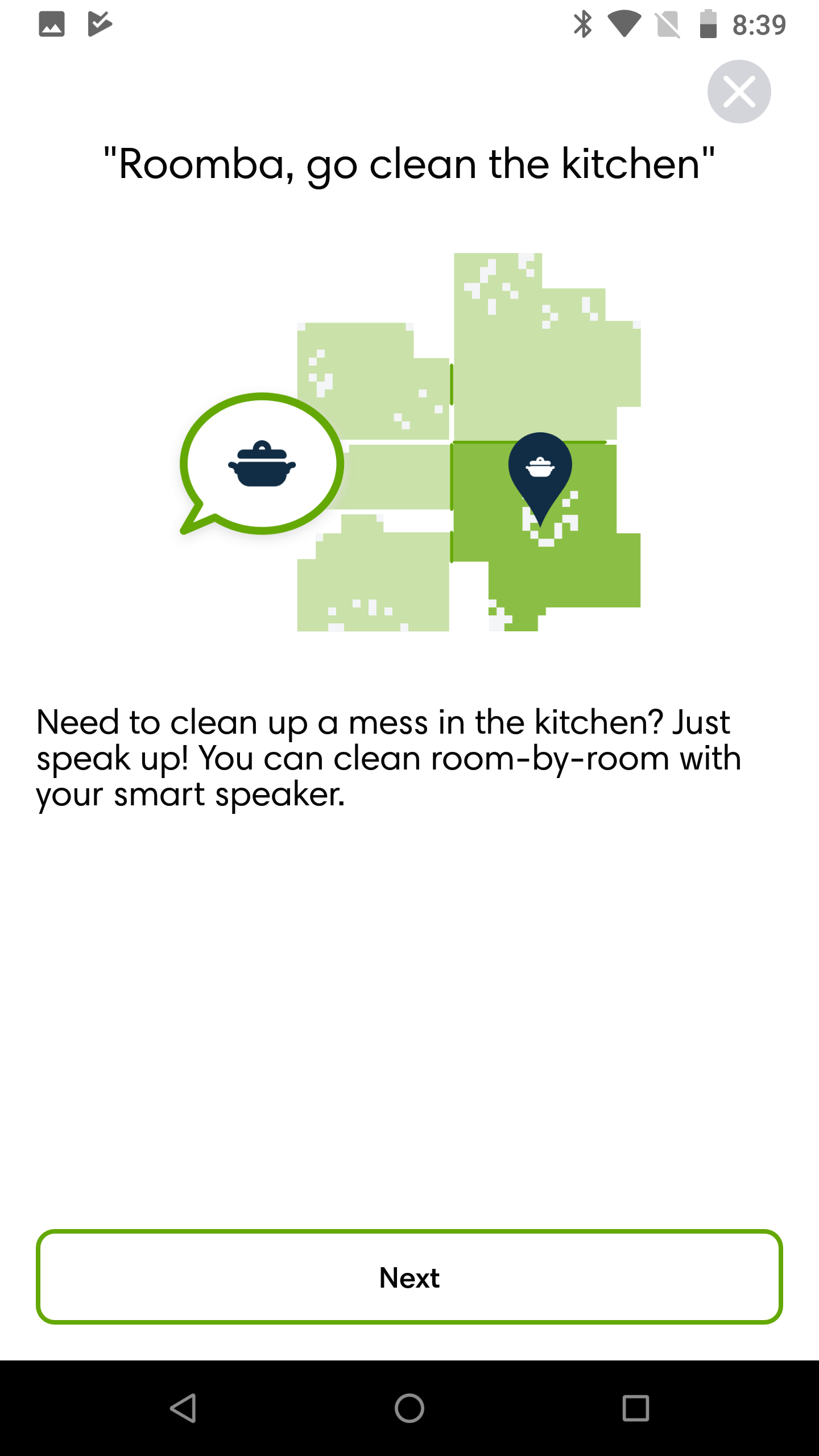
You can select specific rooms on the mobile app, or you can use your voice to do the same thing.
For example, you can shout “Alexa, ask Roomba to clean the dining room.” or “Hey Google, clean the dining room.”
The use of voice commands to clean a specific room has not been done in robotic vacuums before. This new technology is fun to use, but the abilities and reach of this technology will only improve and grow from here on out.
There are other features of the mobile app as well. You will get alerts and status of both robots on the app. You will be able to see where the robot has cleaned as well as what is left to be cleaned. You will also know the status of the battery and if the Roomba is actively cleaning, done cleaning or recharging.
Bottom Line: The Roomba i7/i7+ wins this round. The Imprint Smart Mapping technology is an important update that the 980 doesn’t offer.
Brushless rollers makes dealing with hair easy, and is the same on both models
Starting with the 800 series, iRobot did away with bristle-brush rollers and replaced them with rubber bladed twin extractors. The i7+ model has the same extractor bars as well.
[easyazon_image align=”center” height=”500″ identifier=”B06XRT2B3P” locale=”US” src=”https://smartrobotichome.com/wp-content/uploads/2018/10/51XaZIBT0RL.jpg” tag=”srh-easyazon-20″ width=”500″]These bars rotate in opposite directions to collect, lift, and separate dirt dust and debris. The front bar is designed to agitate carpet fibers and sweep hard flooring debris. It also has the job of pulling in the debris pushed under the robot by the side brush.
The rear bar rotates opposite of the front one, making the rubber blades interlock as they spin. This allows the debris to be lifted for collection. It also separates larger debris and keeps hairs from wrapping around the bars as often.
As these are moving parts, there will be instances where strings or hairs do get wrapped around the bars. However because they are tangle free, the removal of the bound debris is simple.
All you have to do is remove the bars form the robot with the press of a single lever. Once they are out, you just wipe them off with your hand (or a napkin). They don’t get stuck and tangled as they do on bristle-brush rolls.
Once they are wiped off, you just need to pop them back into place and you are good to go.
Bottom Line: This round is a tie. Both the Roomba 980 and i7+ use the tangle free brushless extractors.
Frequently Asked Questions
I am sure you have plenty of questions, especially about the new i7+. I will answer the most common questions here. As always, if you still have questions or concerns, use the comment section below.
Q. What Happens when these robots run over a cord or something they shouldn’t pick up?
A. Each robot is equipped with a laser that will disintegrate any obstacle it cannot suction up. No, seriously, what happens is that the extractor bars will notify the robot that something is caught.
When this happens, the robots will attempt to free themselves. First, they will stop moving. Then the extractor bars will reverse in an attempt to dislodge the item. If that works, the robot will maneuver around the obstacle if it can.
If the reversing doesn’t free the robot, it will shut down to save battery life and protect the motor. It will then send out a series of beeps letting you know that it is caught and needs assistance.
Q. When is the robot going to be available for purchase?
A. The Roomba 980 has been available online and in retail stores since 2015. The i7 and i7+ are both also widely available now.
Q. With the brushless extractors, what happens if the robot runs over power cords or throw rugs?
A. The extractors have a tangle sensor. If the robot runs over a power cord, shoestring or another item that shouldn’t be collected or is too large to fit, the robot will stop the extractors and reverse them in an attempt to free itself.
If it is successful, the robot will maneuver around the cord or item. If, on the other hand, it is unable to remove the blockage, the robot will shut down and send an audible alert to let you know it is stuck.
In this event, you will need to free the robot from the obstruction manually and restart the cleaning cycle. As long as you don’t move the robot more than 2 feet from its previous course and press the clean button once, it will pick up where it left off and stay on track without getting lost in its map.
Q. What kind of filters do the Roomba robots have?
A. The Roomba 980 and the i7+ use iRobot’s high-efficiency filters. Roomba has discontinued the use of the HEPA certification. However, the filters that used to be HEPA certified a few years ago are the exact same filters in the robots today.
The high-efficiency filters will capture 99.9 percent of in-home allergens. So if you suffer allergies, this is great news. Mold, pollen, dust mites and pet dander are all collected.
HEPA certification requires that filters collect particles down to three microns in size. The Roomba high-efficiency filters collect particles down to three microns in size. While they don’t have the certification label anymore, they are still allergen protecting filters.
Q. What kind of containment can be used with the robots?
A. The Roomba 980 can use either of the virtual barriers that have been released by the company. The original barrier was known as the Virtual Lighthouse. This barrier worked by using infrared beams to block off doorways, entryways and portions of rooms.
When the robot encountered the beam, it would treat it like a physical wall and change direction.
The other, more popular, a method is the dual mode virtual wall barrier. These little towers produce the same straight line beam (up to 10 feet) to block off doorways and such like the lighthouses. However, there is also halo mode, which puts out a 4-foot diameter ring.
This ring is useful to keep things on the floor safe from the robot such as pet food dishes, floor lamps, vases, etc. The Roomba 980 comes with a dual mode virtual wall barrier and you can purchase more from the iRobot store.
The Roomba i7+ will also be compatible with the dual mode virtual wall barriers, and it also ships with one in the box.
You can also use the Imprint Smart Mapping on the app as a sort of containment. By telling the robot only to clean certain rooms, you will avoid the robot accessing different areas of your home.
Q. What happens when parts wear out?
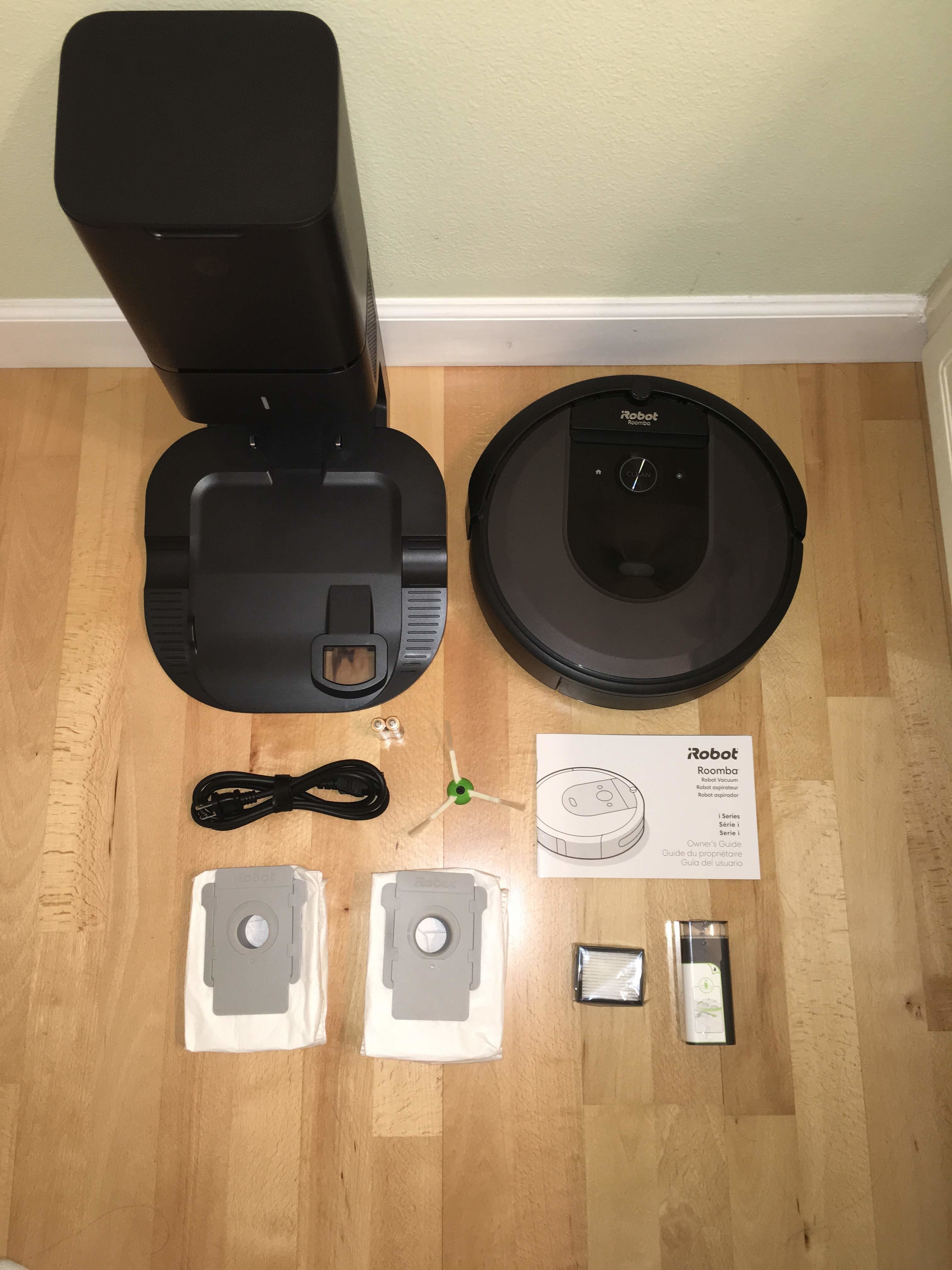
A. Parts of the robots will wear down over time. You will need to replace certain parts from time to time. The part most often needed replacement will be the filters. The documentation suggests the filters should be replaced every four to six months.
When you empty the collection bins, you should check the filters. When you can no longer knock the debris free, replace them. This can fall in the recommended time frame or be sooner. Some users report they need to replace the filter on their 980 every couple of months while others have gone eight months or more.
The side brushes will also wear out and need to be replaced eventually. This is usually a nine to 12-month replacement. The good news is that both the i7+ and the 980 come with an extra filter and extra side brush to get you started.
Every now and then the extractor bars will need to be replaced as well. This is recommended annually but can be longer if they are taken care of. When you do your maintenance routine, you should inspect the side brush and extractors for damage or signs of excessive wear.
For the i7+ you will also need replacement bags for the collection bin tower system. These will come in packs of three bags. One package should last you about two and a half to three months, maybe more, depending on how much debris is collected daily.
You can find all the replacement parts in the iRobot store. There are other online places to get them as well, such as Amazon. However, if you are replacing the battery, I recommend getting it from the iRobot store only.
Some reports from people buying the battery from third-party sellers have reported the wrong battery was sent, or the battery was already used. This isn’t something you want to experience and the only way to get a certified battery that won’t void your warranty is to get it from iRobot themselves.
What I Like About the Roomba 980
- The large collection bin for less frequent emptying.
- The battery provides plenty of power and life to clean most size floors in a single charge.
- The mobile app is arguably the best in the business.
- Deep clean with the extractor bars without the fuss of bristles.
- Rated for all floor types, including high pile carpet.
What I Like About the Roomba i7+
- Everything from the Roomba 980 plus…
- Imprint Smart Mapping allows customized cleaning cycles like never before.
- IAdapt 3.0 technology maps your home and allows the machine to navigate with precision.
- The Clean Base means you never have to deal with the mess of the collection bin again.
What I Really Like About the Roomba i7
- Everything good about the i7+ (just without the ability to self-empty)
- Cheaper price.
- Ability to upgrade to i7+ if you change your mind
In Conclusion
It is no secret that Roomba plans to stay on top of the market. With the release of the i7+ model, it is clear that they have advanced the technology to the point of dominance in the field.
The i7+ is likely the best robotic vacuum on the market today. Of course, calling one model the absolute best is purely an opinion, but there is a lot of facts (and technology) to secure that opinion to most consumers.
The smartphone app is well-made and the voice controls work well. Automatic disposal means one less thing to do (until it’s time to take out your wallet to buy a new vacuum bag, that is). The i7+ is one step closer to full automation.
If you happen upon a good sale on the Roomba 980, you should definitely take advantage of the lower price and pull the trigger on a 980. It was the king of robot vacuums for the past few years for good reason. If you don’t have multiple floors in your home and you don’t plan to take it over to your neighbor’s house, there isn’t a real need for the multiple floor plan memory. Likewise, the use of the voice or mobile app activated customized cleaning is fun, but can be missed if you want to save a few dollars.
If you have problems emptying the dust bin, or simply want the top of the line, best of the best, that is certainly the Roomba i7+ at this time.
If you want the best of both worlds (cheaper price + smarter mapping), the best bet is to go with the i7. The only thing missing on the i7 is the self-emptying Clean Base.
For the significant savings you get, emptying a collection bin isn’t really that much of a hassle.
With the ability to upgrade to i7+ by buying the clean base separately later, there is no reason not to go with the Roomba i7.
Click here for all the robot vacuum deals on Amazon today.
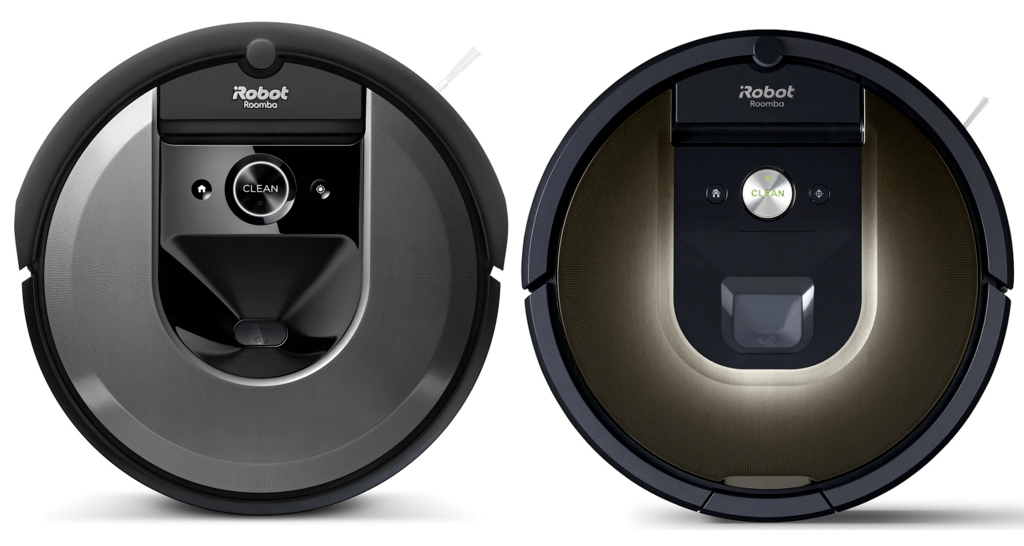
Do you suggest buying a protection plan?
Hi Peggy,
I usually don’t buy protection plans for purchases. If the product fails during the warranty period, most companies are really good about taking care of the problem. If it does not fail during the warranty period, then theoretically there’s nothing flawed about the unit and hopefully it won’t fail after.
Another thing to note is that most credit card companies have extended warranties if you use to pay for the product.
Hope that helps!
I highly recommend buying electronic equipment from Hammacher Schlemmer! HS has an automatic lifetime warranty on all its products, and if HS doesn’t carry the product anymore you get a credit for your original price plus tax. I bought a Scooba NINE YEARS AGO for $450 plus tax (same price as Amazon), it recently broke, and HS credited me $517. So I used it towards the Roomba i7 ($799 which is the same price as on Amazon.) Buying from Hammacher Schlemmer is the best purchase protection plan there is.
Another option is buying your Roomba with the credit card (such as Costco) that offers at least 1 (sometimes 2) years of extra protection when the manufacturers warranty ends.
Hi Ginger,
Thank you for this awesome and potentially money saving tip! I’m sure other readers will appreciate this.